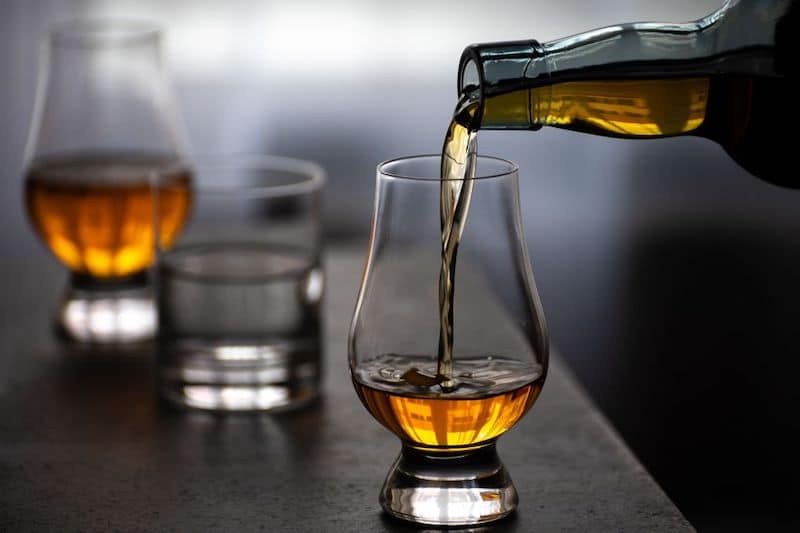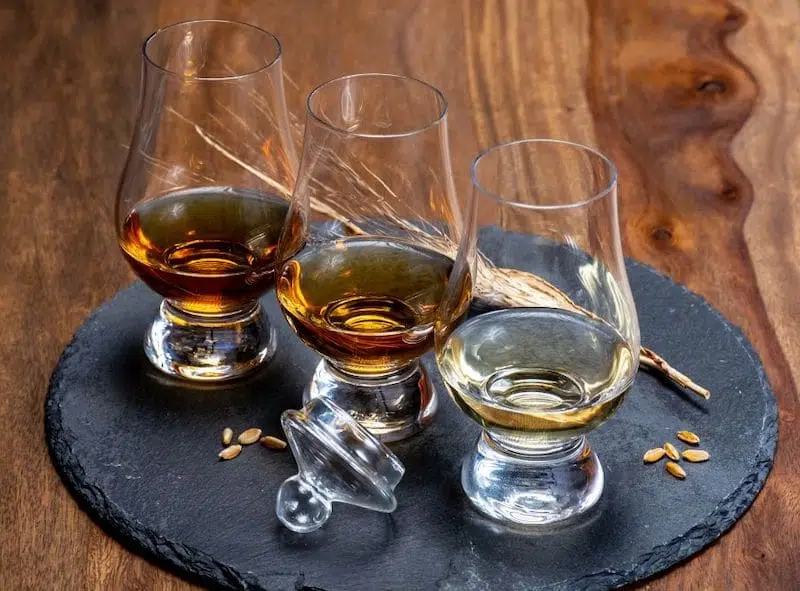You can only produce true Scotch whisky in distilleries on Scottish land. The grain spirit that is primarily known for its occasionally smoky, peaty flavor is primarily made of malted barley. However, other grains like wheat, corn, and rye may also be part of the ingredient list.
Whisky from Scotland comes in various types and styles. These types of Scotch define how the spirit is distilled, which grains producers must use, and how they can blend their products.
The most common types of Scotch Whisky are:
- Single Malt
- and Blended Scotch.
Especially, Single Malt is very well-known. Further, there are three lesser-known sorts:
- Single Grain
- Blended Malt
- and Blended Grain Scotch.
You can produce each Scotch type in each of the 5 Scotch regions. The resulting spirits may show differences due to different climates and production techniques in these regions.
The 5 Types of Scotch and How They Differ
Now, let's look into the five different types of Scotch. The first is the most popular one, the Single Malt Scotch.
Single Malt Whisky Scotch

A Single Malt Scotch Whisky is a premium product. The term Single Malt means that this Scotch consists of 100% malted barley and is distilled in pot stills at a single distillery. You may blend it with Whiskies from other casks, but -again- all of them have to come from the same distillery.
Single Malt is considered premium whisky, and people perceive it as superior to blends. That is amplified by the fact that bottles of this type are usually pricier than other whiskies. As a result, people new to Scottish whisky will often buy Single Malt by default- although, when asked, they rarely know why.
In fact, Single Malt Scotch is not automatically smoother, richer, or better than other types. It comes entirely down to personal taste, which you like best.
Recommended Single Malt brands: Macallan, Glenfiddich, Oban, and Ardbeg.
Single Grain Scotch Whisky
Single Grain Scotch is not as widespread as Single Malt, and only a few distilleries specialize in producing it. It is often lighter and not as complex as malt whiskies and typically used to lend body to Blended Scotch.
The list of ingredients in Single Grain Scotch can include various grains, including barley, wheat, rye, and corn. Similar to a Single Malt, it needs to be distilled at one distillery - hence Single. Yet instead of pot stills, producers usually use column stills for making Single Grain.
Renowned brands that produce Single Grain Scotch: Glendalough and Loch Lomond.

Blended Malt Scotch
Like Single Malt, Blended Malt Scotch is made from 100% malted barley - hence the term malt. But instead of coming from only one distillery, this type of Scottish whisky is made from products from at least two different distilleries.
In the past, Blended Malt was also known as "vatted" or "pure" malt. These days, it is a rare sight because there's so little demand for blended Malt Scotch.
Blended Grain Scotch
Analogous to Blended Malt, Blended Grain Scotch is a combination of at least two Single Grain Whiskies from different distilleries. Since Single Grain is already rare, Blended Grain is even rarer.
If you're curious and want to try some out, try the whiskies from The Famous Grouse. This Scotch producer specializes in making excellent blended Scotch products, including Blended Grain, Blended Malt, and Blended Scotch.
Blended Scotch Whisky
Blended Scotch has the loosest regulations of all five variations and is a blend of at least one Single Malt Scotch and one Single Grain Scotch from different distilleries.
This style of Scotch is known for its balanced taste and smoothness.
The flavors of this spirit make it ideal for mixed drinks and Scotch cocktails.
Recommended Blended Scotch whisky brands: Johnny Walker, Dewar's, and Famous Grouse.
Comparing Single Malt vs. Blended Scotch
When it comes to Scotch whiskey, two main types stand out: Single Malt Scotch and Blended Scotch. While both have distinct characteristics and allure, they offer different experiences to whisky enthusiasts.
As already mentioned, Single Malt Scotch is crafted exclusively from 100% malted barley and must come from a single distillery. These whiskies are renowned for their intensity of flavors, as they are often aged for an extended time, resulting in a fuller and more complex taste profile. Single malts are more expensive due to their limited production and exceptional quality.
On the other hand, Blended Scotch is a harmonious combination of 15-40% single malt scotch and 60-85% grain whiskey, technically known as single grain scotch, which is predominantly made from wheat. Blended scotches are lighter and more affordable to produce, leading to a milder flavor profile that is easier to drink. They are excellent options for mixing into whiskey cocktails due to their versatility and ability to complement other ingredients.
Below is a comparison table highlighting the key differences between Single Malt Scotch and Blended Scotch:
| Aspect | Single Malt Scotch | Blended Scotch |
|---|---|---|
| Ingredients | 100% malted barley from a single distillery | Blend of 15-40% single malt scotch and 60-85% single grain scotch |
| Flavor Profile | Intense, complex, and full-bodied | Milder, better-balanced, and more approachable |
| Ageing | Often aged for longer | Varies depending on components |
| Price | Usually more expensive | Generally more affordable |
| Usage | Enjoyed neat or with a splash of water | Great for mixing into cocktails |
While you may be tempted to view single malts as superior, purer expressions of Scotch, and blends as budget options mainly for mixing, it's essential to appreciate them as distinct styles, each with its own merits.
Single Malt Scotch showcases the singular expression of a distillery, offering a remarkable depth of character, while Blended Scotch masterfully combines different whiskies to achieve balance and versatility. Both have their place in the whisky world, catering to specific preferences and occasions.
How does the taste of these Scotch types vary?
Scotch Whisky is known for its diversity in flavors, and you cannot define the taste by the type. Especially, because these differences are only partly due to the production processes. A lot of the variety also is yielded by these regional differences.
For example, when looking for a smoky Scotch with hints of seaweed, suggesting picking a Single Malt or Single Grain won't be helpful. However, recommending a Scotch from Islay (like Lagavulin) will likely get you what you're after. Of course, this doesn't apply to all products from this region, but it's a good rule of thumb.
However, to give you an idea of the taste of the different types, here are a few guidelines:
- Single Malt: Like all aged spirits, Single Malt has distinct notes of oak, honey, and vanilla. It's rich in flavor, and due to its malted barley base, you can also detect s subtle malty notes.
- Single Grain: This is much lighter and generally less flavorful in comparison to their malt-based peers. Single Grain whisky often offers notes like toffee, caramel, butterscotch, and toast.
- Blended Malt: Blended Malt whisky is more complex than Single Malt as is typically made from a selection of Scotch with different flavor profiles.
- Blended Grain: This style is still light, similar to Single Grain whisky, but with a more complex and richer flavor profile.
- Blended Scotch: tends to be gentler and better balanced in taste than other Scotch styles, which makes it great for mixing in Scotch cocktails.
Which type of Scotch tastes smoky?
Scotch is known for its smoky, peaty flavor. However, not every Scotch whisky has this distinct character. The smoky aroma and taste are also not limited to certain Scotch varieties. Instead, it is a step in the malting process before distillation, lending the spirit its smoky note.
The captivating smoky flavor found in peated Scotch is a result of the intricate interplay of various factors during its production. One of the most influential elements is "peat," a type of soil rich in decomposed vegetation found in bogs and wetlands that is young coal.
During the final step in the malting process, barley is dried in a kiln, and sometimes this kiln is fueled with peat, seasoning the smoke that penetrates the barley and imbuing it with a distinct smoky essence. The toasting and distillation process further enhance this smoky profile, creating an enchanting peat flavor that carries all the way to the bottle.
Scotches that incorporate peat are often referred to as "peated" or "peaty." This style originated in Scotland, where peat is a vital fuel source for rural areas for centuries. While peated whiskies are predominantly associated with Scotch, they also exist in regions like Japan, Ireland, and the United States, delighting whisky enthusiasts with their smoky charm.
How is Scotch different from other whiskey?
Since Scotch is a specific type of whiskey, it is not different but has characteristics that make it unique.
The main aspects of Scotch Whisky
- Grains - Made from malted barley, rye, and wheat.
- Aging process - Aged for at least three years in oak barrels.
- Flavor - A smooth spirit with a touch of peated smoke
- The Spelling - whisky instead of whiskey
- Origin - must come from one of the five Whiskey regions in Scotland: Speyside, Islay, Highland, Lowland, and Campbeltown.
Another requirement of Scotch whisky regulations is that the spirit, once bottled, must contain at least 40% ABV. Scotch fresh from the barrels usually holds a lot more alcohol and is watered down in most cases until it reaches an alcohol content of 40% to 45%.
What kind of Barrels are used to age Scotch?
The maturation process of Scotch plays a key role in shaping its distinct flavors, with barrels playing a significant role in this transformation. Approximately 70% of Scotch's flavors are acquired from the barrels used during aging.
Interestingly, unlike other tightly regulated production aspects, Scotch barrel aging offers a wide array of options, making it the most diverse whisky category globally. Scotch must mature for at least three years in oak barrels, and the possibilities for barrel selection are vast.
Over 90% of the Scotch is aged in ex-bourbon barrels, which impart coconut, vanilla, and toffee notes and allow for extended aging without overwhelming oakiness. Another common choice is ex-sherry casks, which bestow rich flavors of dried fruit and a subtle nuttiness.
Additionally, Scotch enthusiasts enjoy the uniqueness of multiple barrel combinations and "finishing" techniques, where rum, port, Madeira, and sherry casks, among others, provide a final layer of complexity.
The Scotch regions
Scotch can only be made in Scotland, more precisely in one of the following Scotch whisky regions:
- Highland
- Lowland
- Campbeltown
- Islay
- Speyside
- Islands
Each of these regions has a different climate and soil conditions that result in flavor differences in the final products. Speyside Whiskies, for example, are known for their fruity flavors with notes of apple, pear, honey, and vanilla. The Lowland whiskies, on the other hand, are much smoother with more refined palates and flavors like honeysuckle, cream, ginger, and cinnamon.
The last one on the list, the Islands, is not officially recognized as one of the distinct Scotch regions. However, whisky produced on these islands can, of course, legally be named Scotch.
If you want more details on the popular spirit, read our Scotch Whisky Guide.

